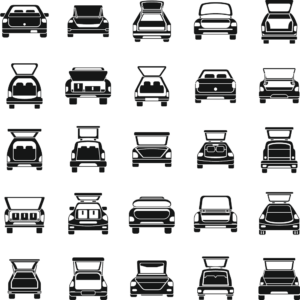All-Wheel Drive vs Four-Wheel Drive: What’s The Difference?

When discussing vehicles, it’s quite common to hear people use the terms “all-wheel drive” and “four-wheel drive” interchangeably. However, what many people do not realize is that they are two completely different drive-trains with entirely different purposes. In this article, we’ll clear up the confusion by explaining the differences, and then give you a breakdown of some of the pros and cons of these drive-trains compared to their two-wheel drive counterparts.
In This Article
All-Wheel Drive
Four-Wheel Drive
Pros and Cons
All-Wheel Drive
Not every all-wheel drive system is created equal. Different manufacturers will often produce slightly altered configurations. However, for the purposes of this article, we will discuss the standard definition of all-wheel drive.
The basic goal of an all-wheel drive system is to distribute the appropriate amount of power to each individual wheel depending on the conditions of the moment. For example, suppose that you are at a stop light during a snowstorm. When the light turns green, you go to accelerate, but one wheel can’t get any traction and just keeps spinning. An all-wheel drive system will detect that through the use of various sensors and send more power to the wheels that have better traction, thus allowing the vehicle to start moving.
The way that this is accomplished is through the use of differentials. A differential is essentially a set of gears that allows power to be distributed between different wheels. An all-wheel drive vehicle will have a front, rear, and center differential. These components allow for power to be distributed appropriately not only between the right and left wheels, but between the front and rear wheels as well. All-wheel drive is associated more with vehicles that tend to stay on the road. Crossover SUVs, Wagons, and even some sedans are known for their all-wheel drive option.
Four-Wheel Drive
Unlike all-wheel drive, four-wheel drive (otherwise known as 4WD, 4×4, or four-by-four) tends to be associated more with vehicles that may go off-road, such as trucks and large SUVs.
A four-wheel drive system’s main goal is to deliver power evenly between each wheel without preference, thus allowing each wheel to spin at an even rate. This is accomplished through the use of a device called a transfer case. With four-wheel drive vehicles, power is routed from the engine to the transmission, and then through the transfer case where it is divided evenly among all 4 wheels. This equal split of power results in increased maneuverability in low traction situations, such as dirt or gravel.
Unfortunately, the same system that allows four-wheel drive vehicles to perform so well off-road hinders their performance on regular terrain. This is because when a vehicle is turning, the wheels want to travel at different speeds. A four-wheel drive system does not allow that, which can result in a more difficult driving experience.
However, unlike their all-wheel drive counterparts, four-wheel drive systems are often referred to as “part-time four-wheel drive” because they can be turned off, reverting the vehicle to two-wheel drive. By allowing the driver control over when to engage the four-wheel drive system, the vehicle can realize the benefits of four-wheel drive without hindering performance on regular pavement.
Pros and Cons
The major selling point for both all-wheel and four-wheel drive systems is the increased traction and stability that you gain when driving in sub-optimal conditions. For many people, such as those who live in climates with harsh winters, that benefit alone outweighs any negatives.
All-wheel and four-wheel drive vehicles also tend to fetch more money when it comes time for resale.
However, there are also some drawbacks to consider.
All-wheel drive and four-wheel drive vehicles are almost universally going to be more expensive than their two-wheel drive counterparts. This is true not only in the purchase price of the vehicle, but in terms of fuel economy as well. Two-wheel drive vehicles tend to get more miles per gallon than their all-wheel and four-wheel counterparts.
Additionally, all-wheel and four-wheel drive systems are more complex than two-wheel drive systems, and as a result can be more costly to repair should something go wrong.
Which drivetrain is right for you is going to be dependent on your individual circumstances. However, this article should have equipped you with enough information to be able to assess the situation and make an informed decision on what type of vehicle will suit your needs. If you’d like to further discuss your options, please give us a call at (800) 243-0182 or send us an email at info@motorlease.com
Ready to wave goodbye to fleet management headaches?
Let Motorlease take the wheel! Our fleet experts will handle all your vehicle needs. Experience the joyride of turnkey fleet management!Categories


